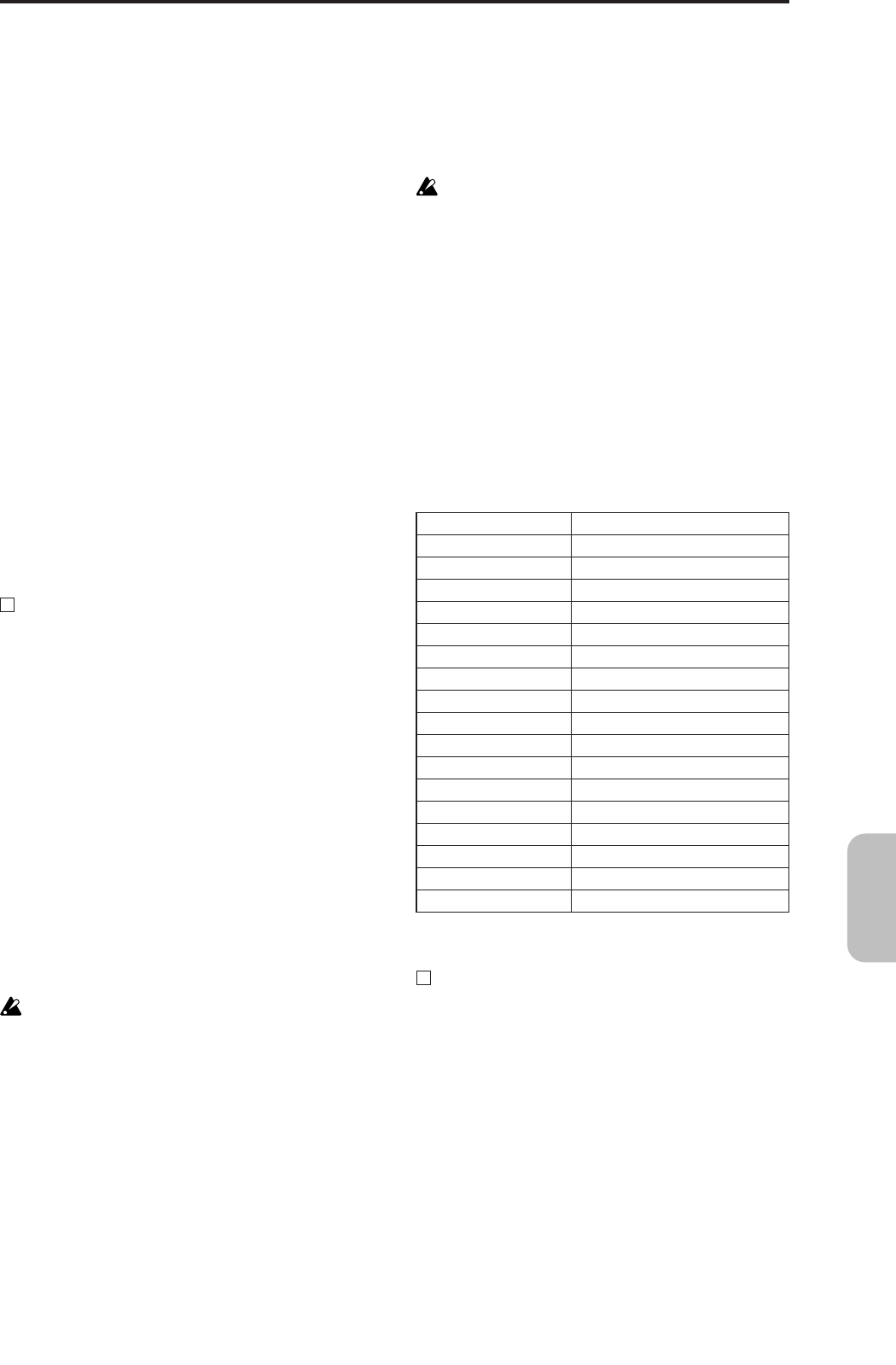
179
Appendices
Local Control On: Notes from the arpeggiator will be trans-
mitted from the MIDI OUT. Normally you will use this set-
ting.
Local Control Off: Notes from the arpeggiator will not be
transmitted from the MIDI OUT. The arpeggiator will only
sound the notes (on this instrument).
Setting example 1
Record the note messages generated by the arpeggiator on
the external MIDI sequencer/computer
Turn on this instrument’s arpeggiator. Set this instrument to
Local Control On.
Turn Local Control On for this instrument.
Turn Echo Back Off on your external sequencer/computer.
By turning echo back off, you will prevent the arpeggiator
from performing duplicate processing on the monitored
notes during recording.
During playback, turn off the arpeggiator of this instrument.
Setting example 2
Use the external MIDI sequencer/computer to record only
the notes that trigger the arpeggiator, and operate this
instrument’s arpeggiator for monitoring while recording,
and during playback.
Turn on the X50/microX’s arpeggiator. Set the X50/microX
to Local Control Off. The note messages generated by the
arpeggiator will not be output. On your external MIDI
sequencer/computer, turn echo back on. With these set-
tings, the data will be recorded and played correctly, and the
arpeggiator will not be applied in duplicate.
About GM/GS/XG
the X50/microX supports the GM standard. It also supports
the GM sound map (including bank select) with 128 pro-
grams and 9 drum programs provided in ROM banks G,
and g(d). (g(d) contains drum programs.)
GM is a standard that ensures basic compatibility of sounds
etc. between different GM-compatible instruments made by
different manufacturers, but you need to be aware of the fol-
lowing.
• The GM System On message is received only in Multi
mode. (“GM Initialize” MULTI 0–1)
• When a GM System On message is received, the system
will be initialized for GM compatibility. (☞p.57 “GM
Initialize”)
Roland GS and Yamaha XG are specifications by which these
respective manufacturers have extended the GM standard.
The X50/microX automatically converts the GS/XG sound
maps to the GM sound map, and supports some of their
messages. In Multi mode etc., GS/XG music data can be
played back.
Since the X50/microX does not support all of the GS/
XG sound maps or messages, some data may not be
played back correctly.
If you wish to play music data from an external GM/GS/XG
compatible sequencer, or to load it into a pattern (multi), set
“Bank Map” (GLOBAL 0–2a) to GM.
Converting the GS/XG bank/program maps
to the GM2 bank/program map
• When bank select/program change messages used by
GS/XG are received, they will automatically be
converted to the G, g(d) bank/program map of this
instrument.
For banks that are used in common by GS/XG, GS
Reset/XG System ON will be received to automatically
convert to the optimal bank/program map for each.
Support for GS/XG part mode exclusive mes-
sages
• In Multi mode when GS/XG part mode exclusive
messages Drum or MDrm 1–4 are received, bank g(d)
(GM drum bank) will be selected for the specified track.
Until this part mode state is defeated, bank select mes-
sages will no longer be received for the specified track.
Support for NRPN messages used in GS/XG
music data
The following NRPN messages can be received to modify
the sound.
kk: Drum Inst No. ([0C...6C] corresponds to C0...C8)
* [00, 01...7f] corresponds to Random, L000...R127)
About standard MIDI files
Standard MIDI files (SMF) make it possible for different
computer programs or musical instruments made by differ-
ent manufacturers to exchange time-based MIDI data.
When playing back SMF data, the program bank that is
selected will depend on the “Bank Map” setting (GLOBAL
0–2a). If you are playing back SMF data that complies with
the GM/GS/XG specifications, set “Bank Map” to GM.
Vibrato Rate [Bn, 63, 01, Bn, 62, 08, Bn, 06, mm]
Vibrato Depth [Bn, 63, 01, Bn, 62, 09, Bn, 06, mm]
Vibrato Delay [Bn, 63, 01, Bn, 62, 0A, Bn, 06, mm]
Filter Cutoff [Bn, 63, 01, Bn, 62, 20, Bn, 06, mm]
Resonance [Bn, 63, 01, Bn, 62, 21, Bn, 06, mm]
EG Attack Time [Bn, 63, 01, Bn, 62, 63, Bn, 06, mm]
EG Decay Time [Bn, 63, 01, Bn, 62, 64, Bn, 06, mm]
EG Release Time [Bn, 63, 01, Bn, 62, 66, Bn, 06, mm]
Drum Filter Cutoff [Bn, 63, 14, Bn, 62, kk, Bn, 06, mm]
Drum Filter Resonance [Bn, 63, 15, Bn, 62, kk, Bn, 06, mm]
Drum EG Attack Time [Bn, 63, 16, Bn, 62, kk, Bn, 06, mm]
Drum EG Decay Time [Bn, 63, 17, Bn, 62, kk, Bn, 06, mm]
Drum Coarse Tune [Bn, 63, 18, Bn, 62, kk, Bn, 06, mm]
Drum Fine Tune [Bn, 63, 19, Bn, 62, kk, Bn, 06, mm]
Drum Volume [Bn, 63, 1A, Bn, 62, kk, Bn, 06, mm]
Drum Pan [Bn, 63, 1C, Bn, 62, kk, Bn, 06, mm]*
Drum Rev Send (Send2) [Bn, 63, 1D, Bn, 62, kk, Bn, 06, mm]
Drum Cho Send (Send1) [Bn, 63, 1E, Bn, 62, kk, Bn, 06, mm]


















